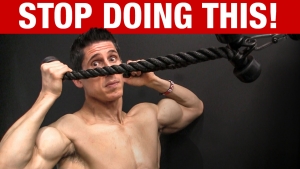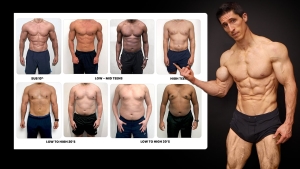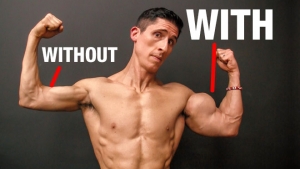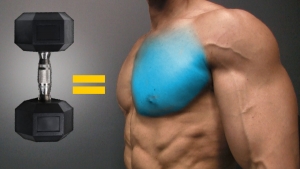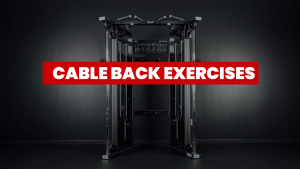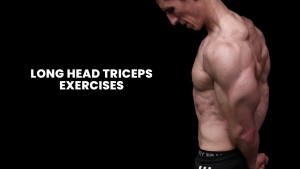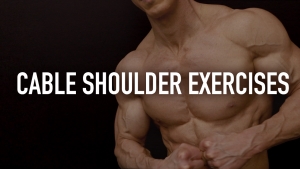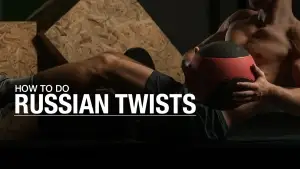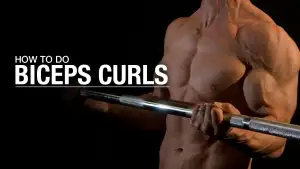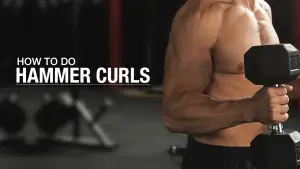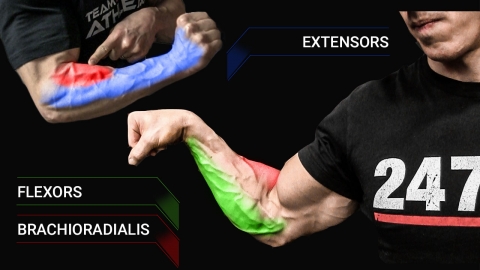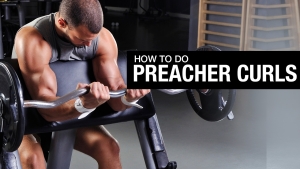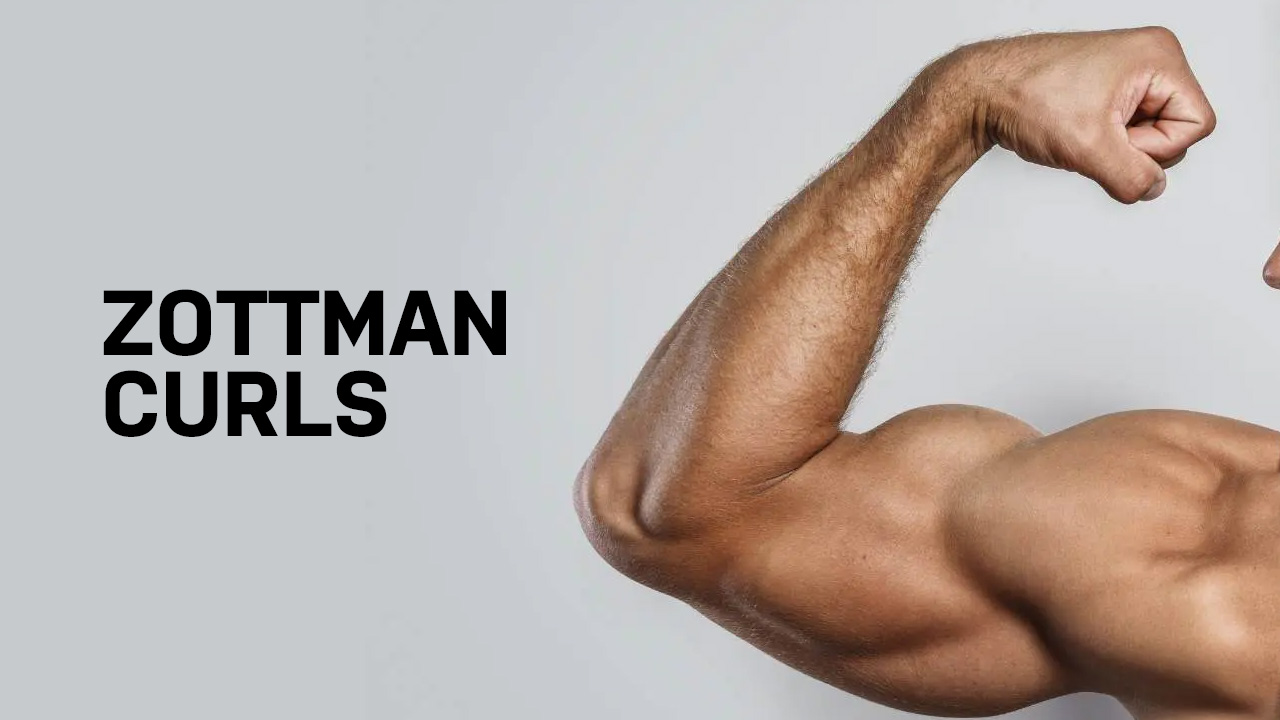
WHY DO ZOTTMAN CURLS?
They’ll perform three sets of Barbell Curls, a few Hammer Curls, maybe some Wrist Curls, if they remember.
The problem? Your arms don’t function in neatly separated muscle groups outside the gym.
The biceps brachii doesn’t operate in isolation, and if you’re ignoring the forearms, you’re building a weak link that will fail you on everything from Pull-Ups to Rows.
This is where the Zottman Curl can help.
A Philadelphia-based Strongman named George Zottman is credited with creating the famous Zottman Curl.
On the way up, the Zottman Curl is every bit as effective as a strict Bicep Curl for building the upper arm. But the real magic happens on the way down.
By rotating into a Reverse Curl grip for the eccentric phase, you put the brakes on the descent and hit the brachioradialis and forearm extensors with eccentric overload that they’ll never get from a standard curl.
Despite being one of the best dumbbell exercises for the arms, it’s not nearly as popular as the classics. And today, I’m hoping to change that.
Let’s talk about how the Zottman Curl works, the muscles it targets, how to perform it with perfect form, and the common mistakes to avoid.
ZOTTMAN CURLS: MUSCLES WORKED
To understand why the Zottman Curl works so well, you’ve got to know what’s happening inside the muscles during the lift.
Most people think “biceps” and immediately picture the big, round muscle you see in a flex. That’s the biceps brachii, but there’s more going on underneath the surface.
BICEPS BRACHII: SHORT HEAD

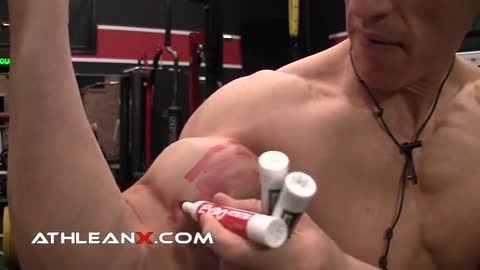
This is the short head of the biceps brachii that sits on the inner side of your upper arm, closer to your torso.
It starts from a small bump on the shoulder blade and assists with elbow flexion or pulling your forearm toward your upper arm.
It also helps with supination, which is that palm-up twist you do at the top of a Dumbbell Curl.
On top of that, it contributes to shoulder flexion, helping lift your arm forward.
When performing the Zottman Curl, the short head is fully engaged during the concentric phase, or lifting, portion of the rep.
BICEPS BRACHII: LONG HEAD

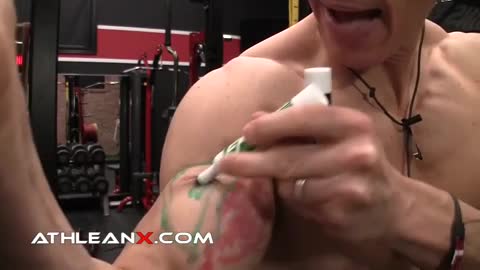
This is the long head that runs along the outer side of the upper arm, next to the triceps brachii, and it’s the part that gives the biceps their peak.
It starts just above your shoulder joint and runs through a groove at the top of your upper arm bone.
Like the short head of the biceps, the long head is responsible for elbow flexion and supination, but it also plays a key role in stabilizing the shoulder joint during heavy lifts.
That stability matters when you’re handling dumbbells and controlling the slow, reverse curl lowering in the eccentric portion of a Zottman Curl.
BRACHIALIS

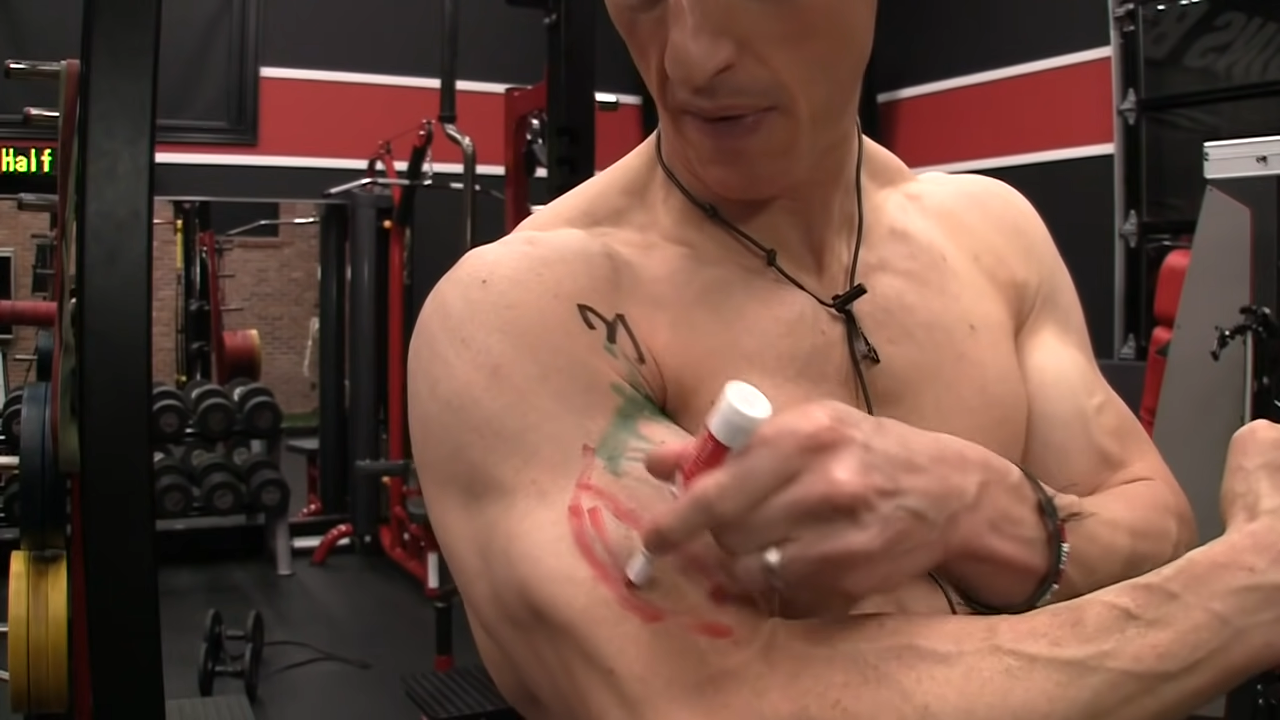
Technically not part of the biceps brachii, the brachialis sits underneath it and that’s exactly why it matters. When it grows, it pushes the biceps up, creating more arm size from every angle.
It’s a pure elbow flexor, meaning it’s working regardless of your grip position.
Targeting it can be the difference between decent arms and arms that stretch your shirt sleeves.
FOREARMS
The Zottman Curl isn’t just an upper arm exercise. It’s one of the best forearm developers you can do without adding extra sets of Wrist Curls.
The brachioradialis works hard during the eccentric overload of the Reverse Curl phase, especially when you lower the weight slowly.
Meanwhile, your wrist flexors and extensors stabilize the dumbbell as you rotate through forearm supination and forearm pronation (from palm-up to palm-down).
Neglecting these muscles can lead to grip weaknesses and imbalances, but the Zottman Curl trains them under a much heavier load than isolation moves.
ZOTTMAN CURL BENEFITS (WHY IT WORKS)
Most lifters split their arm training into biceps work and forearm work using separate exercises, separate sets, separate time.
The Zottman Curl eliminates that inefficiency by combining two proven movements into one seamless lift.
Here’s why you need to start using Zottman Curls in your workout program.
TWO EXERCISES IN ONE
On the way up, you’re putting the biceps in their strongest position: palms up, elbows pinned, curling with strict control.
This is where you get maximum contraction and squeeze out the most from every inch of the lift.
But the second you reach the top, the game changes. You rotate the wrists, palms down, and the forearms take over.
Now it’s about controlling the weight against gravity, making every fiber in your forearms fight to keep it steady.
What makes it so effective is that you’re not separating these into two single joint exercises with rest in between.
You’re stacking them into one fluid rep, giving the biceps and forearms back-to-back work under continuous tension.
That means more total stimulus in less time and the kind of carryover strength you’ll notice in every other pulling movement you do.
GRIP STRENGTH DEVELOPMENT
The pronated lowering phase is grip training at its most functional. Keeping the dumbbell locked in a palm-down position under load forces your wrist, finger flexors, and smaller stabilizers to work overtime.
Over weeks and months, this builds the kind of grip that carries over to bigger lifts and daily life.
Pull-Ups become more secure, Bent-Over Rows feel more stable, and heavy Barbell Deadlifts stop being limited by your hands.
Even outside the gym, you’ll notice it when carrying heavy groceries, holding onto awkward objects, or performing any task that requires a sustained grip.
Stronger grip strength is a limiting factor in more lifts than you think. By improving it here, you remove a bottleneck in your overall strength.
FOREARM HYPERTROPHY
Most curl variations hit the forearms only as stabilizers. The Zottman Curl actively trains them as prime movers during the eccentric phase.
When you rotate into that Reverse Curl position and control the descent for 3 to 4 seconds, you’re putting the brachioradialis and wrist extensors under heavy, prolonged tension.
This kind of eccentric overload is one of the most effective ways to stimulate muscle growth, particularly in stubborn muscles like the forearms.
This leads to thicker, more developed forearms that balance the look of your upper arm and enhance the aesthetic flow from shoulder to wrist.
Big biceps with thin forearms look incomplete. This exercise fixes that without needing extra wrist curls or isolation forearm work.
INJURY PREVENTION
If all you ever do is straight-bar, palms-up curls, you’re loading the same joints, tendons, and small stabilizing muscles in exactly the same way over and over again.
That’s why so many lifters end up with nagging elbow or forearm pain.
The Zottman Curl changes the equation. Rotating from palms-up to palms-down mid-rep shifts the stress to different muscles and stabilizers in the wrists and elbows.
This balanced loading gives overworked tissues a break while strengthening the smaller muscles that keep those joints healthy.
For lifters who feel discomfort during heavy Barbell Curls, or athletes who put a lot of repetitive strain on the forearms, this variation can be a joint-friendly way to keep training hard without grinding those problem areas into the ground.
EASY TO PROGRESS OR REGRESS
The Zottman Curl isn’t locked into one rigid setup. You can scale it up or down to match where you’re at.
If you’re new to the movement, start seated with lighter weight and focus on controlling the rotation and the slow lowering.
Once your form is locked in, progress to standing, alternating arms, or even using the Cable Zottman Curl for constant tension.
You can also adjust the tempo to fit your goals.
Beginners can slow both the lift and the lowering to learn control, while advanced lifters can keep the curl explosive but make the eccentric brutally slow to pile on extra muscle damage.
It’s a movement that grows with you, instead of one you outgrow.
HOW TO DO ZOTTMAN CURLS
The Zottman Curl isn’t about moving weight from point A to point B. It’s about controlling the weight through two very different phases.
On the way up, you’re in a strong, palm-up position, firing the biceps for maximum contraction.
At the top, everything changes. You rotate into a palm-down grip and shift the load to the forearms, forcing them to control a slow, punishing descent.
Here’s how to get every ounce of benefit from the movement.
ZOTTMAN CURLS

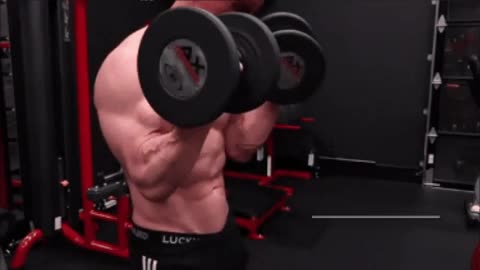
HOW TO DO THE ZOTTMAN CURL:
- Grab a pair of dumbbells but start lighter than you think. The Zottman Curl requires control, not just strength, so light to moderate weight is best.
- Stand with your feet shoulder-width apart. Hold the dumbbells at your sides with your palms facing forward. Keep your chest tall and shoulders back.
- Drive the weight upward by bending at the elbows, keeping your palms facing the ceiling. Lock your elbows in place so only your forearms move through the lift.
- Once you’ve reached the top of the curl, pause briefly. Rotate your wrists so your palms are facing down.
- Lower the dumbbells under control for 3 to 4 seconds. Focus on feeling your forearms and grip working to resist gravity.
- Return to the starting position with palms forward. Go right into the next rep without swinging or rushing.
WHAT MAKES IT EFFECTIVE: Most arm exercises force you to choose between hitting the biceps hard or hammering the forearms. Zottman Curls remove that trade-off. They load the biceps in their strongest position during the lift, then flip the script and challenge the forearms when they’re most capable of controlling the weight. This shift from a supinated grip curl to a pronated lowering phase matches the exercise to the natural strengths of each muscle group. The result is more total muscle tension, better use of the eccentric phase, and a single movement that covers what normally takes two or three separate exercises.
ZOTTMAN CURLS: COMMON MISTAKES
The Zottman Curl works because it forces you to train two different movements back-to-back in one rep. But if your form falls apart, you lose the benefits that make it so effective.
Here’s what most lifters get wrong, why it kills your results, and how to fix it.
USING TOO MUCH WEIGHT
One of the fastest ways to wreck this exercise is by loading up too heavy.
When the dumbbells are too heavy, you end up swinging through the concentric and letting gravity free-fall the eccentric phase.
That turns the movement into a sloppy hybrid of bad Biceps Curls and uncontrolled Reverse Curls.
The Zottman Curl isn’t about moving the most weight. It’s about controlling the weight through the entire range of motion.
Lighten up to a point where you can lift with zero momentum, keep your elbows locked in, and own the lowering phase for 3 to 4 seconds.
You’ll quickly find that 20 pounds with perfect form and execution will work your arms harder than 40 pounds done like a Cheat Curl.
Pick a weight you could do for 12 to 15 reps during a familiar biceps exercise like Incline DB Curls. That will usually put you in the right range for clean, controlled Zottmans.
RUSHING THE ECCENTRIC
The eccentric phase or the slow lowering with a pronated curls (palm-down) grip is the entire reason this exercise hammers the forearms and brachioradialis.
Rush it, and you erase the forearm-building benefit.
Think about it this way: on the way up, you’re essentially doing a strict curl. On the way down, you’re doing a loaded Reverse Curl, which most people can’t handle as much weight on.
That’s why the slow descent is non-negotiable. It gives your forearms time under tension they’ll never get from Standard Biceps Curls, Barbell Curls, or even EZ-Bar Curls.
Count “one-two” on the way up, then “one-two-three-four” on the way down. That 3 to 4 second eccentric overload is where the magic happens.
ELBOWS FLARING FORWARD
If your elbows drift forward during the lift, you shift load off the biceps and onto the shoulders.
Not only does this reduce biceps activation, but it also changes the mechanics of the exercise, so you lose the intended forearm muscles engagement in the lowering phase.
Your elbows should act like hinges, staying pinned to your sides and letting only the forearms move.
This keeps tension locked into the biceps brachii on the way up and ensures the forearms work hard during the reverse curl lowering.
Imagine your elbows glued to your ribcage. If they move, you’re doing it wrong. Filming yourself from the side can make it obvious if they’re creeping forward.
OVER-ROTATING THE WRISTS
You don’t need a full 180-degree spin to switch from palm-up to palm-down.
Over-rotating can put unnecessary torque on the wrists and cause discomfort, especially if you already have mobility limitations.
The goal is a smooth, natural rotation. Rotate just enough to move from the supinated curl position to the pronated reverse curl position at the top of the movement.
Think of it as a controlled transition, not a flashy spin.
Rotate your wrists only until your palms are facing the floor. Keep your grip neutral and your wrist straight throughout the lowering phase.
TURNING IT INTO A STANDARD CURL
The biggest mistake? Skipping the pronated lowering altogether.
If you curl up palm-up and than lower palm-up, you’re just doing another set of Biceps Curls. That’s fine for the biceps, but you’ve thrown away the forearm work that makes the Zottman Curl so unique.
The whole point of the exercise is to train the biceps in their strongest position on the way up and the forearms in their strongest position on the way down.
Every rep should end with the reverse curl eccentric. If you’re struggling to maintain the pronated grip on the way down, drop the weight and rebuild your control.
ZOTTMAN CURLS: ADVANCED TECHNIQUES
Once you’ve mastered the basics of the Zottman Curl, you don’t have to just keep adding weight to make it harder.
There are smarter ways to progress including methods that challenge your muscles with more time under tension, increased grip demand, and strategic fatigue.
Here are five ways to take the exercise to the next level without wrecking your form.
TEMPO PAUSES AT THE TOP AND BOTTOM
Pauses create isometric tension, which teaches the muscle to contract harder and more effectively.
The top pause maximizes the peak contraction of the biceps, while the bottom pause ensures your forearms and grip initiate the next rep without relying on momentum.
You also eliminate the “stretch reflex,” which means every rep has to be earned.
HOW TO DO IT:
Perform the curl normally, keeping your elbows pinned and your palms facing up. When you reach the top, hold for 1 to 2 seconds.
During that pause, actively squeeze the biceps as hard as possible, like you’re trying to crush the dumbbell in your hand.
After the squeeze, rotate smoothly to a palms-down grip for the eccentric. At the bottom of the rep, pause again for 1 to 2 seconds.
This dead stop prevents you from bouncing into the next rep and forces you to start each lift from a position of complete control.
DROP SETS FOR ARM FINISHERS
Drop sets extend the set past the point of normal muscular failure, recruiting additional muscle fibers and forcing the upper body to adapt.
For the Zottman Curl, this means not just more biceps fatigue, but forearm fatigue as well, which is an area most lifters rarely push to failure.
Done at the end of an arm workout, it ensures you leave nothing in the tank.
HOW TO DO IT:
Select a weight that challenges you for 8 to 10 strict Zottman Curls.
When you can’t perform another clean rep, immediately switch to a lighter weight, roughly 20 to 30% lighter, and continue for another 6–8 reps.
If you’re up for a true burnout, drop the weight again and push for as many reps as possible.
Keep rest time minimal between drops to keep the muscles under constant tension.
FAT-GRIP HANDLES FOR EXTRA GRIP CHALLENGE
A thicker handle increases the distance your fingers have to stretch around the weight, which recruits more muscle fibers in the forearms and hands just to hold it.
This makes the biceps and forearms work harder in every phase of the curl.
Over time, this leads to crushing grip strength and dense forearm musculature. These are qualities that directly carry over to Pull-Ups, Deadlifts, Rows, and any sport that relies on grip endurance.
HOW TO DO IT:
Slide fat-grip attachments onto your dumbbells or use a thicker-handled implement.
Perform the Zottman Curl exactly as normal but expect to drop your working weight by 10 to 30% because your grip will fatigue faster.
Focus on keeping your wrists straight and stable during the entire lift.
1.5 REP METHOD
This exercise technique keeps the muscles working in the mid-range, where they’re strongest and can produce the most force.
You’re doubling the time the biceps are under load before the forearms even get involved.
Then, when you rotate into the eccentric, your already-fatigued grip and forearms have to control a heavier-than-usual challenge.
It’s brutal for both muscle groups and a great plateau buster.
HOW TO DO IT:
Curl the weight up to the top. Lower halfway down, then curl it back up to the top again before rotating to palms down and performing the full eccentric.
That entire sequence (up, halfway down, back up, full slow lowering) counts as one rep.
Start with 6 to 8 of these and build from there.
SLOW-MOTION ECCENTRIC SETS
The eccentric phase is where the majority of muscle damage (and therefore growth stimulus) occurs.
By extending it to 6 to 8 seconds, you create significantly more mechanical tension in the forearms and biceps.
This also teaches you discipline in controlling the descent, instead of letting gravity take over. The forearm burn from this method is intense.
HOW TO DO IT:
Perform the curl up at a normal tempo, for about 1 to 2 seconds, then rotate to palms down and take 6 to 8 full seconds to lower the weight.
Keep your elbows locked in and your wrists stable the entire time. Start with lighter weight until you can maintain control for all reps.
Strong arms aren’t built by accident. They’re built by smart strength training.
The Zottman Curl gives you two muscle-building moves in every rep, targeting both the show muscles and the ones that keep you performing.
Make it a staple, and you’ll notice the difference in the mirror and under the bar.
Check out our complete line of ATHLEAN-RX Supplements and find the best training program for you based on your fitness level and goals.

- The Zottman Curl trains the biceps in their strongest position on the way up and the forearms in their strongest position on the way down, hitting both in a single, controlled movement.
- Here’s how to perform Zottman Curls:
- Don’t grab the heaviest dumbbells in the rack. The Zottman Curl is all about control, not showing off. Start lighter than you think so you can own every inch of the rep without cheating.
- Stand with your feet shoulder-width apart, chest tall, and shoulders pulled back.
- Hold the dumbbells at your sides with palms facing forward. This is your “ready” position.
- With your palms turned upward, lift the dumbbells toward your shoulders in one smooth, deliberate motion.
- Keep your elbows locked to your sides. If they move forward, you’re losing tension where you want it most.
- At the top, pause for a moment, then rotate your wrists so your palms face down. This is where the forearms take over.
- Lower the dumbbells slowly, taking 3 to 4 seconds to get to the bottom. Fight gravity the entire way and feel your forearms and grip working overtime.
- Return to the starting position, palms forward, and go right into the next rep. No swinging, no rushing. Make every rep count.
ZOTTMAN CURLS FAQ
The Zottman Curl is a complete arm-builder.
The curling phase targets the biceps, both the short head for inner thickness and the long head for that outer peak.
Then, by rotating into a palms-down grip at the top, you hand the load off to your forearms for the lowering phase.
This hits the brachioradialis, wrist extensors, and smaller stabilizers in the wrists and elbows that most lifters neglect.
This combination builds stronger, fuller arms from elbow to shoulder, while also improving grip strength for bigger lifts like pull-ups, rows, and deadlifts.
It depends on what you’re after. If your goal is maximum biceps isolation and you don’t care about forearm strength, a strict Dumbbell Bicep Curl will let you load more weight and zero in on the biceps alone.
Variations like Incline Bicep Curls, Cable Bicep Curls, or even Pinwheel Curls can also be used if your focus is purely on biceps growth.
But the Zottman Curl delivers more total arm value in a single movement. It trains the biceps in their strongest position on the way up and the forearms in their strongest position on the way down.
That means you get balanced development and functional grip strength without having to add extra exercises.
For most lifters, especially those who don’t already train forearms directly, the Zottman Curl will give you more bang for your buck.
Start lighter than you think since control is more important than load here.
Stand tall with your chest up and shoulders back, dumbbells at your sides, palms facing forward.
Curl the weight up with a palms-up grip, keeping your elbows pinned to your sides.
At the top, pause briefly, rotate to a palms-down grip, and lower the weight slowly for 3 to 4 seconds.
Keep your wrists neutral (don’t let them collapse) and fight gravity the whole way down.
Return to the starting position and go straight into the next rep without swinging or rushing.
Choose a weight you can control for 12 to 15 clean reps without your form falling apart.
If you’re rushing the eccentric, letting your elbows drift forward, or losing your wrist position, the dumbbells are too heavy.
As a rule of thumb, most lifters will use about 60% to 70% of what they’d normally handle for Traditional Curls.
This allows you to keep the biceps working on the way up and still have enough control to challenge the forearms on the way down.
Remember, the goal isn’t just to move the weight. It’s to make the muscles work harder for longer.
REFERENCES
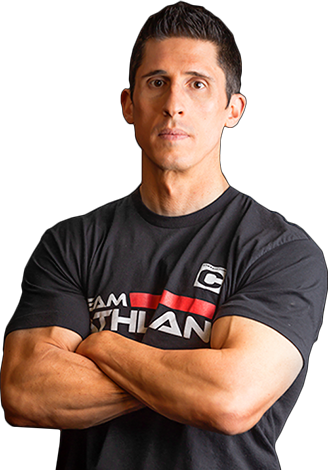
Jeff Cavaliere M.S.P.T, CSCS
Jeff Cavaliere is a Physical Therapist, Strength Coach and creator of the ATHLEAN-X Training Programs and ATHLEAN-Rx Supplements. He has a Masters in Physical Therapy (MSPT) and has worked as Head Physical Therapist for the New York Mets, as well as training many elite professional athletes in Major League Baseball, NFL, MMA and professional wrestling. His programs produce “next level” achievements in muscle size, strength and performance for professional athletes and anyone looking to build a muscular athletic physique.
